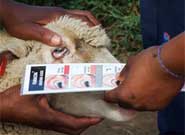More than 900 million people in the developing world live below the poverty line in rural areas. Just one animal can meet a whole family’s needs, offering individuals a way out of poverty, but deadly and debilitating livestock diseases jeopardize this and lead to an increase in food prices.
Parasitic worms that live in the gut of livestock are a major constraint on animal production and a particular problem for small ruminant production, much of which, in India and South Africa, lies in the hands of resource-poor smallholder farmers.
For several decades control of parasitic diseases has relied heavily on the use of anthelmintic drugs. This has inevitably led to the parasites developing a resistance to these kinds of drugs, thus exacerbating the problem of worm control.
In order to increase the prosperity of smallholder farmers, it is thus vital to develop and implement sustainable worm control strategies by adopting a targeted selective treatment (TST) approach. Such an approach involves a proportion of the flock or herd being left untreated, thus reducing the chances of them developing resistance to the drugs.
In South Africa, researchers have led the world in implementing TST approaches using a system which grades parasite-induced anaemia in sheep against the colour of the eyeball (see image). Treatments can then be directed to where they are needed, saving limited resources and improving sustainability. This is possible because most of the parasite population is concentrated in just a few hosts, so good worm control at the group level can be achieved by treating as few as 20 per cent of the animals, provided those individuals are correctly identified.
Such approaches, though successful, are more complex to implement and require a higher level of expertise than could reasonably be expected from resource-poor smallholder farmers and, indeed, most animal health advisors. Therefore, Dr Morgan and colleagues at the University of Pretoria will use their BBSRC/DfID grant to develop an automated decision support system, delivered via mobile phones, to advise South African farmers on drug usage.
Dr Morgan said: “This project will promote effective and sustainable use of anthelmintics and slow the development of resistance to these drugs by the development and application of existing technology. It will allow a growing number of resource-poor farmers to manage worms economically and sustainably, without the need for frequent laboratory sampling and regular inputs by experts into day-to-day decisions on worm management.
“This will contribute to improved animal health and productivity, protecting food security and enhancing the economic benefits and sustainability of small ruminant production in less developed countries.”
The project also involves development of locally produced vaccines against worms with colleagues at the Moredun Research Institute in Edinburgh, and the Universities of Calgary, Canada, and Tamil Nadu, India.
